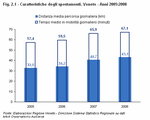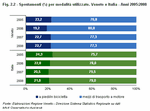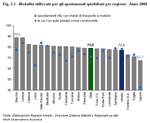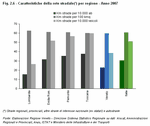The theme of mobility, in and outside of cities, has long been of interest not only to local authorities but also on a European scale; so much so that the last few years have seen developments in European policies and legislation in this sector.
The European Union has produced several documents on the subject of mobility, including the "Action Plan on Urban Mobility" dated 30th September 2009. Taking as a starting point the fact that "in 2007, 72% of the European population lived in urban areas, which are key to growth and employment"; that "cities need efficient transport systems to support their economy and the welfare of their inhabitants"; that "urban mobility is a growing concern to citizens" and that it "is also a central component of long-distance transport"; and that "most transport, both passenger and freight, starts and ends in urban areas", the action plan proposes practical actions within a coherent framework of initiatives in the area of urban mobility. The aim, moreover, is to promote integrated policies, well aware of the fact that "an integrated approach can best deal with: the complexity of urban transport systems, the governance issues and the links between cities and their surrounding areas or regions, the interdependence between transport modes, the limitations within urban space and the role of urban systems in the wider European transport system. An integrated approach is not only needed for the development of transport infrastructure and services, but also for policy making to link transport with environmental protection, healthy environments, land use planning, housing, social aspects of accessibility and mobility as well as industrial policy. Developing strategic, integrated transport planning, establishing appropriate mobility planning organisations and setting realistic targets are essential to address the long-term challenges or urban mobility, while supporting also cooperation with and between transport operators."
The points made in this document completely fit the situation in Veneto today; it is almost as if our region stood for all of the issues and problems surrounding the issue of mobility.
Indeed, mobility within Veneto involves issues such as the consequences of the region's geographical-economic location, the standard of its road networks, logistics, the cost of mobility for goods and for people, the negative impact of traffic, and the particular layout of local conurbations.
Veneto lies in a strategic location in Europe due to its network of major cross-trade traffic routes (East-West, North-South) and to the recent enlargement of the European Union, which has moved the centre of the continent eastwards. This new-found location at the heart of Europe should be considered in terms of both physical distance and as a gateway towards the East and the South of the world. However, although Veneto's location does put it in a privileged position and give it a competitive edge, there are also causes for concern. Veneto is subject to a continual increase in through-traffic which, at the moment, occupies the same road space as the short-distance traffic travelling within the region.
Another contributing factor to the traffic of people and goods crossing Veneto, besides its geographical-economic location, is the particular layout of local conurbations, which gives rise to urban sprawl, a common characteristic of the central area of the region. This means that people live in one place, take their children to school in another place, work in another place, do their shopping in another place etc. etc. This leads to a higher demand for transport amongst inhabitants, which tends to involve above all private means.
A few simple pieces of information can help to give an idea of the general nature of mobility in Veneto.
Over the years, the time spent travelling and the distance travelled every day have increased. Motorised transport remains the most common means. Every day, in 2008, the average person travelled 43 km (33 km in 2005) and spent 67 minutes travelling (57 minutes in 2005).
(Figure 2.1) and
(Figure 2.2).
The car plays a leading role in daily journeys in 2008 too: according to Isfort data, 77% of people leaving their homes (Italian figure: 79%) for reasons of work, study, family or leisure use a motorised means of transport; 78% of the time this is their car (Italian figure: 71.4%)
(Figure 2.3).
If we focus our attention on those who use a motorised means of transport, and look in particular at changes in preferences for the various means of transport occurring from 2005 to 2008, we can see that although the number of people driving their own cars decreased, this was not balanced out by an increase in the use of public transport. Rather, there was an increase in travelling in a car as a passenger-a good sign because it appears that car-pooling initiatives are becoming more wide-spread-and in the use of motorcycles, mopeds or a combination of different means of transport
(Figure 2.4).
The increase in traffic is testimony to the ever increasing number of vehicles on the roads, not only in Veneto but in the whole of Italy too. In 2008, the last year for which data is available, vehicle stock was on the increase: there were more than 3,800,000 vehicles, of which 76% were cars. In six years the number of vehicles on the roads in Veneto increased by 11.5%, the smallest increase was of 9% in the province of Venezia and the highest in the province of Treviso at around 13%
(Table 2.1)
The number of vehicles per 100 residents is 78 (Italian figure: 80), this is 3 more than six years ago. Numbers are on the increase in the provinces of Rovigo and Belluno in particular
(Figure 2.5).
If we look at cars in particular, in 2008 there were from 59 to 61 cars per 100 residents in all of the provinces in Veneto, with the exception of Venezia (a fact that can be accounted for by the infrastructure particular to its provincial capital).
In 2007 Veneto's road network consisted of an overall total of 10,991 km, this includes regional and provincial roads, ex-state roads and motorways. This equals to almost 23 km per 10,000 inhabitants, 60 km per 100 km▓ of surface area and just over 38 km per 10,000 vehicles on the roads
(Figure 2.6).











